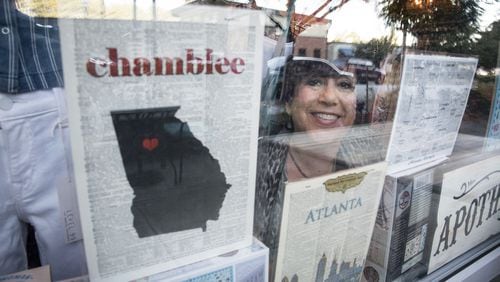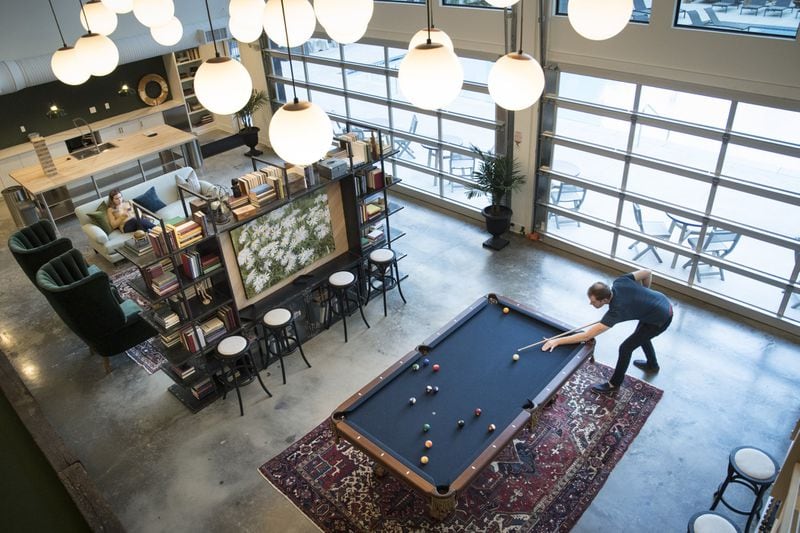For Matthew Clark, it’s convenient, affordable and stylish, the kind of just-ahead-of-the-curve choice that could look pretty darned hip in a few years.
And it’s home.
“I like that this is brand new,” said Clark, 35, of the Olmsted Chamblee apartments where he’s lived since the spring. “You see that developers are looking at it and think it’s up and coming. It’s a good area and it’s growing.”
Other residents walk to the Marta station. He likes the convenience to highways, so he can drive to his job easily.
For decades, Chamblee was an industrial zone, a smattering of residences, car dealerships, antique shops and open lots. Now, it benefits from spillover from higher-priced places like Brookhaven and Buckhead, and it sits in the path of forces of change that are sweeping through much of metro Atlanta – demographics, transit, trendy values and economics.
It is a sign of the times that growth in metro Atlanta is no longer reaching farther out, but instead is filling in gaps and adding density to previous development in places like Chamblee. Young professionals, who are driving the surge, are likely to want more urban settings, mass transit options and cool things to do with fellow millennials.
“Chamblee is definitely changing,” said Kim Fredrickson, co-owner of Hello Gorgeous, a boutique on “Antique Row” on Malone Drive, not far from the Chamblee Marta station. “Just a couple years ago, it felt like a sleepy little town.”
Her store has been open three years. She’s had to constantly reshape the inventory to meet the changing population. Now, she sells more clothes and jewelry for younger buyers.
There are new apartment buildings, most with retail to be added on the ground floor. There is an office building under construction. And – a crucial symbol for millennial move-ins – there is a Whole Foods market around the corner.
Change is accelerating, she said. “There are commercial units on the floors above us and they sell like hotcakes. Real estate agents can’t give me enough of their cards, because they think I’ll hear about things first.”
Among the projects either just finished or underway:
• Parkview on Peachtree, 300 units and 200 more approved
• SLX Atlanta, 297 units
• Malone on Peachtree, 205 units
• Olmsted Chamblee, 283 apartment and townhouse units, a complex that sits on six acres at the corner of Peachtree Boulevard and Chamblee Tucker Road. Construction of the property, once occupied by the International Farmers Market, started more than two years ago by CF Real Estate Services.
The project had the lure of tax incentives, but more than anything, the company has bet on Chamblee’s trajectory, said Brett Oliver, director of development for CF, which also manages the property. “We are just in the path of growth. We were the first. People saw potential, but it was definitely unproven.”
CF’s bet so far looks good — Chamblee hasn’t lost its single-family homes, but more and more residents are living in apartments and condos as the character of Chamblee shifts toward the urban.
That proof is trickling in: The home sales data shows an area heating up, according to an analysis put together by Re/Max at the request of The Atlanta Journal-Constitution.
So far this year, the median price of a home sold in Chamblee is $335,000 – up 5.3 percent from last year and 15.7 percent from 2015, said Re/Max.
If the Chamblee market is picking up speed, demographics have been like a favorable tail-wind. Atlanta the past few years has been the destination for a wave of millennials, many of them young professionals open to – or enthusiastic about – living in apartments or condos.
Olmsted Chamblee was designed with them in mind. There are community areas, rentable offices, a gym with cardio equipment, a yoga room, an art space, a pool, a bocce court, pool table and “raked seating” for lectures or performances.
The price is pitched to young professionals, not bargain-hunters: A one-bedroom apartment of about 720 square feet is $1,342 a month. A two-bedroom of 1,100 square feet is $1,759 and townhomes of 2,500 square feet go for $3,800.
Space like this – and at those prices — would have stayed vacant a few years back. Not anymore. Some of it is economics – many young people do not have the savings needed for a home downpayment. But it is also lifestyle, Oliver said.
“A lot of our folks just don’t want to be tied down,” he said. “They like the flexibility and they like the amenities.”
Demographics is key to Chamblee’s growth, especially the clustering of development around the Marta station, said R. Eric Clarkson, the city’s mayor.
“You have a generation of people who are ready to ride public transit,” he said.
That is why Whole Foods was crucial – as a signal about the kind of community that was growing in the area, he said.
The spot had been vacant and several times, the city had a chance to fill it in ways that echoed Chamblee’s past. Instead, the city stuck to its vision of the future.
At one point, Georgia Power wanted to install an electrical substation there. Then there a proposal to build a huge tire store, he said. “There was lots of pressure and – this was during the recession – we had vacant lots and warehouses. But I said. ‘hold on.’”
The framework for Chamblee’s current growth was set in zoning changes made in 2002, in the development authority’s readiness to issue tax abatements, in the city’s annexations that more than doubled its 3.5 square-mile area and – along with people moving in — propelled the population from 10,000 to 28,000. The city boundaries now are roughly along I-85 from Clairmont Road to Peachtree Road, stretching up to the Chamblee Dunwoody exit at I-285.
Roughly 1,200 apartment or condo units have just come onto the market or are under construction, which likely means an additional 3,000 people in the area.
Among the planning is a nearly mile-long extension of an unused rail trail in the style of the Atlanta Beltline, Clarkson said. “You see development starting to take shape around the idea of creating a livable, walkable community.”
MYAJC.COM: REAL JOURNALISM. REAL LOCAL IMPACT.
AJC Business reporter Michael E. Kanell keeps you updated on the latest news about jobs, housing and consumer issues in metro Atlanta and beyond. You'll find more on myAJC.com, including these stories:
Never miss a minute of what's happening in local business news. Subscribe to myAJC.com.
In other Business news:
About the Author









